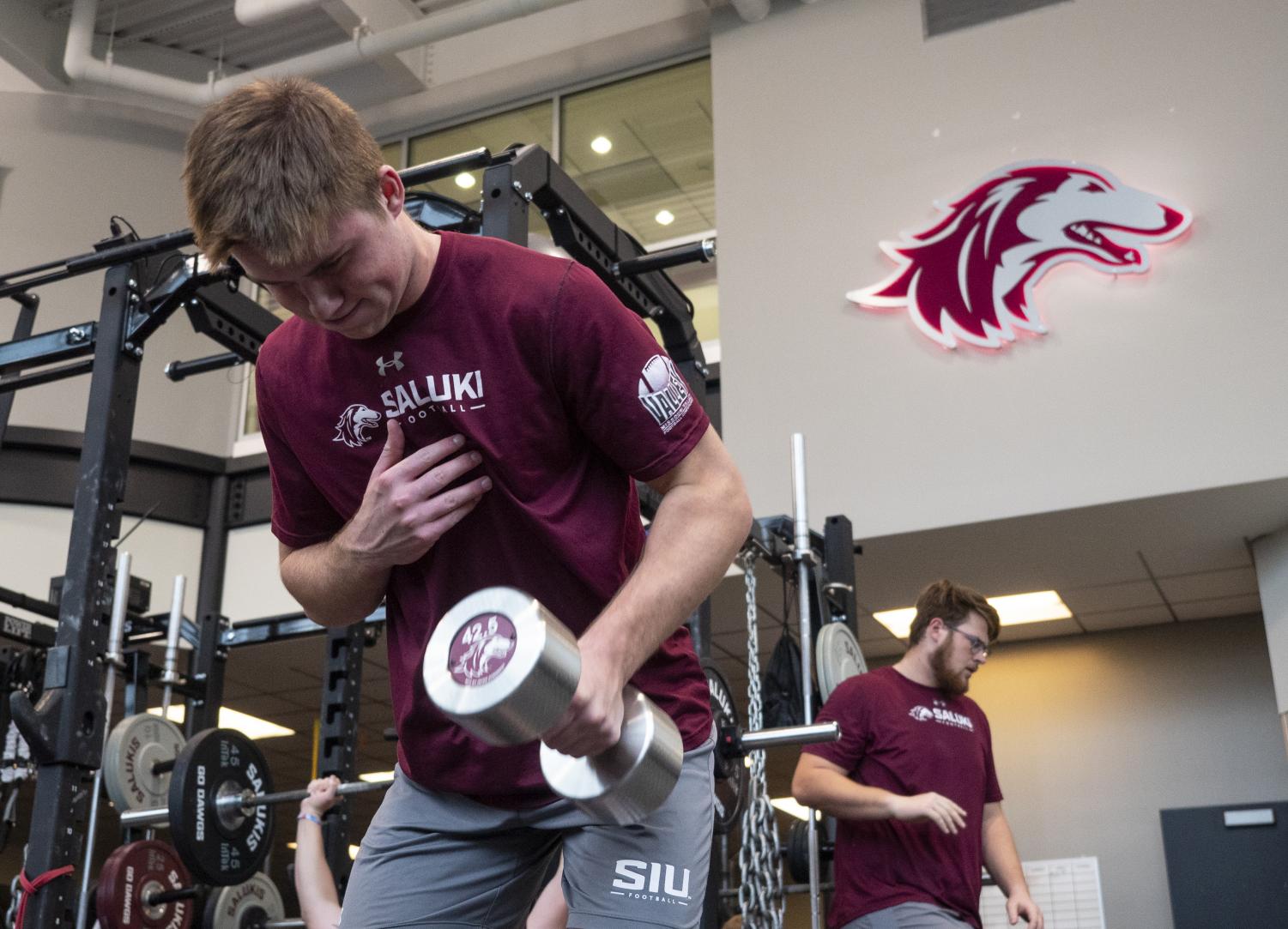Football goes beyond the field: Behind the scenes of SIU’s football training
Carson VanBuskirk | @carsonvanbDE
Sophomore Je’Quan Burton, of Orlando, Fla., studying Sports Administration, lifts a barbell on Friday, Oct. 11, 2019, in the Banterra Center’s Gym.
November 10, 2019
In athletics, the crowd will normally only see performance days or game days. Game day is important, but in order to make it there, players have to go through countless hours of training and practice.
Without strengthening and conditioning, players would be at a higher rate of injury and would not be able to perform at their best abilities.
Meade Smith, who oversees the entire athletic department as far as sports performance goes with all athletes, said there are different training schedules depending on the time of the year and where they are at in the training season.
Advertisement
During the off season, which would be in January and February, the team trains five days a week and depending on where players are in the program are lifting three or four times a week.
“During that period, we have two on the field conditioning days or agility days that are specific towards football as far as doing just normal athletic type movements, and then there’s football-specific movements,” Smith said.
Now during the season, the players lift twice a week, as a team, and have one voluntary day where they go and work out around their practice and class schedule.
Over time, football training has evolved from just lifting weights and running to looking how the players’ bodies move — looking at flexibility and mobility throughout their joints, Smith said.
“What we do in the weight room has to translate to the field,” Smith said. “The stronger we are able to get our guys, the better they move.”
Before any player starts training, they go through exams with trainers.

Branson Combs, of Evansville, Ind., studying Exercise Science, pulls a dumbell to his chest on Friday, Oct. 11, 2019, in the Banterra Center’s Gym.
“We go through every joint, every bone, every muscle, everything,” Kaitlyn Maloney, the head football athletic trainer, said. “We try and find areas that we think might be putting them at risk.”
Advertisement*
Southern’s football training program is based on a level system. What position the players play and how many years they have been a part of the program determines how they will train.
“We do a lot of prevention work so that we can keep them on the field, so they don’t end up in there for injuries,” Maloney said.
Romeir Elliot, a freshman running back for the Salukis, said he specifically trains more on his legs because of height.
“I know guys are going to try to hit me in my legs since I’m already that short,” Elliot said. “I just try to have my legs as strong as possible, so I can just bounce off those tackles.”
Smith said the end goal of training is not for every player to be able to squat 600 pounds or bench 500 pounds.
“The end goal is to make them into better football players on the field,” Smith said
Training areas that are weaker or are a target can prevent possible injury, Smith said.
Smith said it all begins with training the players the right way. He said his plan is to educate the players on how to take care of their bodies.
“If you’re not sleeping correctly, eating correctly, hydrating, getting in the training room for recovery […] you’re not preparing your body to play at the highest level,” Smith said.
Getting the players stronger benefits them in the long run, which translates to how they perform on game day.
Elliott said conditioning gives players the endurance to get through the entire game.
“It reflects it a lot as far as conditioning and lifting but more so conditioning because it helps you get through all four quarters,” said Elliot.
Football is a heavy contact sport, so injuries are not always avoidable. So, when an injury does occur, Southern has a plan to get the players back on the field.
“No matter what the injury is that we want our athletes moving,” Smith said. “Science says you think the first thing you should do after you get hurt is shut your body down, rest, not move. When actually you need to keep moving, and so we want to keep them moving.”
Once the players gain strength back, the maintenance program eases them back into participation instead of throwing them back out onto the field, Maloney said.
“They all know that you can go back on the field, but once you go back on the field, it doesn’t mean you are out of the training room,” Maloney said. “You still have to maintain that strength we got so that it doesn’t happen again. Maintenance for what just happened but also preventative for anything in the future.”
Saluki’s football training program also allows the trainers and coaches to have one on one relationships with the players, Maloney and Smith said.
“One thing I take pride in, is getting to know every single guy on the team,” Smith said.
Smith said his job is to get the best out of every player.
“Everybody’s got different personalities,” Smith said. “I got to learn their different personalities, I got to learn what buttons I can push with guys to get them to go harder.”
It is the same way with the athletic trainers, like Maloney, Smith said.
“I feel like Meade has a great plan for us to get us stronger — mentally and physically,” Elliot said. “I feel like it helps us in the long run for games.”
Staff reporter Ashlyn Ege can be reached at [email protected].
To stay up to date with all your southern Illinois news, follow the Daily Egyptian on Facebook and Twitter.
Advertisement








